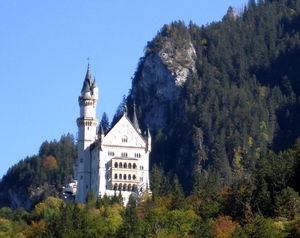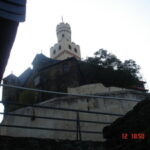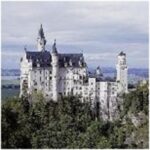Castles are common in Europe. Over the centuries, rulers across the continent sought to display their wealth and power by constructing great works of architectural splendor. Many castles began their lives as defensive fortifications, keeping the rulers safe from attack. Over the centuries, as the instruments of war evolved, castles became less reliable to fend off the blows of ever more powerful cannons and opulence surpassed practicality in design and decoration.
Three of my favorite European castles stand in Southern Germany. Conceived and built by Bavaria’s King Ludwig II in the late nineteenth century, the Neuschwanstein castle and the palaces of Linderhof, and Herrenchiemsee are the beautiful creations of a fanciful imagination. Munich is a stunning historic city and there is much to see but spending a few days in this region just south of Munich is well worth the time.
Newschwanstein
Perched high above the plains in the Alpine foothills, the white satin walls of Neuschwanstein glimmer amid their deep green forest background. This iconic structure was conceived as a fairy-tale castle. Ludwig drew inspiration from the operas of his favorite composer, Richard Wagner. For the king, it was a nostalgic trip back to the medieval Europe of his ancestors. Although the picturesque castle has become overrun in the tourist season, it is well worth a visit. A romantic approach by horse-drawn carriage transports visitors into the fantasy world of knights and maidens.
Inside the castle, visitors are guided through a world of Wagnerian operas. Rooms recreate the stage sets of Ludwig’s favorite operas. Walls are decorated with frescos depicting scenes from his most famous works. Glorious chandeliers, ornately carved wood beams and Byzantine-style mosaics express Ludwig’s opulent taste.
Linderhof
At Linderhof, Ludwig transformed a small hunting lodge into a luxurious yet intimate version of France’s Versailles Palace. The ornate building is adorned lavishly with gold, marble and porcelain. Never intended to be a copy of Versailles, the palace nonetheless evokes the spirit of the opulent French mansion. A notable feature is the Hall of Mirrors. This small room is designed with strategically placed mirrors that give one the illusion of standing in a vast hall such as that at Versailles. Another interesting feature is the dining room table that can be lowered through the floor to the room below. With this, the reclusive king could enjoy his meal without being disturbed by the servants.
Surrounding the palace, the gardens are equally spectacular. Fountains cascade down the hillside in front of the building flanked by carefully manicured formal gardens. On the hillside above the palace, Ludwig created an artificial grotto. Built on an iron framework overlain by a skillfully-crafted cement façade, it looks convincingly like a natural cavern. The fanciful grotto has a lake upon which Ludwig sailed a small clam-shaped boat. The grotto’s electric lamps provided a colorful light show for the king.
Herrenchiemsee
In the palace at Herrenchiemsee, Ludwig sought to not only re-create Versailles but to surpass it. Built on an island in the middle of Bavaria’s largest lake, this is the largest and most extravagant of the three. Unfinished at the time of Ludwig’s death it is nonetheless impressive. The Gallery of Mirrors resembles its famous counterpart at Versailles but is considerably larger. The walls, ceiling, floors, and furnishings of the intimate private apartments and the elaborate public state rooms display the extreme wealth of a European monarch.
Visiting the region
The castle and palaces are located south of Munich in the Alpine foothills. Given the distances involved and the rural setting the best way to experience this area is by car. A visit to any one of the three could be accomplished as a day trip from Munich. However, the best way to savor the rich history and beautiful landscape of this region is to spend a few days here. Use one of the picturesque Bavarian towns such as Oberammergau or Garmisch-Partenkirken as a base to explore.
More from this contributor:
Reignac Castle: France’s Most Unique Chateau
Glenveagh Castle: A Glimmering Outpost in Ireland’s Desolate Northwest
Making the Best of Off-Season Travel to Europe






